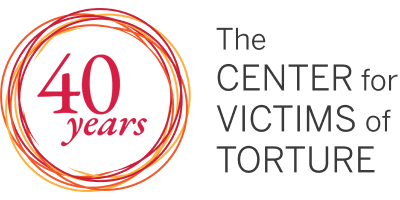It was just over a year ago that CVT opened its doors in Kakuma, a desert town located in Kenya’s northwestern Turkana County. Our clinicians in the region now provide counseling, psychological first aid and, uniquely in a camp setting, physiotherapy (physical therapy) to refugees in and around the Kakuma refugee camps. 180,000 refugees and asylum seekers – many of whom hail from South Sudan – now call the Kakuma region home. They’ve endured hardship and loss, even torture. The demand for CVT’s healing care is immense. As clinicians continue to meet underserved needs in the area, they’re also celebrating the milestones CVT Kakuma’s achieved as it approaches the one-year mark.
Here are a few highlights from CVT Kakuma staff Samuel Orangi, field coordinator, and Joseph Wesonga, physiotherapist/trainer:
Upgraded Housing for CVT Staff
Did you know that CVT Kakuma clinicians live in shippable housing containers? These inhabitable rooms were more affordable than assembling a permanent new structure, but still proved tenacious enough to withstand the climate’s elements. Each container is divided into three rooms, with a bed, toilet, shower and sink. Recently, three trainers on staff (two psychotherapist/trainers and one physical therapy trainer) moved into a more private, concrete area of the residential compound. A new staff kitchen, dining room and training hall became available last June, and are utilized often. Staff says they’re enjoying their new and improved living quarters!
Better Living Conditions at Kalobeyei Settlement
Most of the NGOs (nongovernmental organizations) in the region operate in Kakuma refugee camp. CVT, however, sees clients in the Kalobeyei Settlement, about 25 kilometers from where staff lives. Refugees who live in Kalobeyei are really underserved. The crisis there is enormous. Clinicians complete a significant portion of their work – meetings, paperwork, planning – in the same NGO compound where they live, and travel by van to see clients in the field each day.
Currently, over 30,000 refugees reside in the settlement. In June 2015, after a resurgence of the South Sudanese civil war, Kakuma refugee camp held 180,000 refugees. It was designed to host 70,000. UNHCR (the UN Refugee Agency) thus requested that the Ministry of Interior and National Coordination allot additional land to the rapidly growing refugee population. The Turkana County Government commissioned Kalobeyei Settlement for this purpose. The refugees there were originally living in tents, but the wind is so rough it wasn’t unusual for the iron sheeting to blow off and render the tents uninhabitable. In Kakuma, conditions are harsh. Water is scarce. Windstorms abound. The weather is hot and unpredictable. On the other hand, it can also rain floods, sweep structures away, and render the seasonal rivers to be impassable.
Because the environment is so inhospitable for human and animal vegetation, the government and UNHCR have begun to implement changes to improve the quality of life for refugees at Kalobeyei. Inhabitants are gradually receiving more supplies to build secure, permanent structures for themselves. The schools in Kalobeyei attract refugee children and kids from the local host community, and plans are underway to make water more readily accessible. Some refugee families already own garden plots and are selling their produce to refugees and members of the host community, many of whom are nomadic Kenyan nationals. Government and NGO workers hope that relations between the two groups can improve and flourish.
CVT to Expand at Kalobeyei Settlement
Kakuma’s sprawling Kalobeyei Settlement contains three villages. The villages are separated by approximately 1,000 meters between them, and each village holds thousands of refugees. CVT operates in Village One, with two tukuls used for counseling and one for physiotherapy (physical therapy). This means some clients have to walk 45 minutes to an hour to receive care. If you have money, you could hire a motorbike and get a ride, but it’s expensive. Most clients can’t afford it. For CVT clients who need physiotherapy to address physical wounds and ailments from their torture, the distance can be particularly grueling. That’s why CVT is building a larger physiotherapy room in Village One starting this month, with a shady waiting area so that clients don’t have to wait in 100-degree weather under the hot sun. The current physiotherapy room will be converted into a divided space to see individual clients. Staff also hopes to begin construction of one physiotherapy building and one counseling tukul in Village Three.
At CVT Kakuma, Clients Get Better
One benefit of the spread-out villages at Kalobeyei is that the distance sometimes serves as a benchmark for clients’ progress. As survivors begin to heal throughout the 10-week group counseling and physiotherapy sessions, long walks to Village One for healing care don’t seem as insurmountable. In fact, a CVT client who significantly recovered while receiving physiotherapy recently told staff, “Now I can walk from Village One to Village Three. Soon, I’ll walk all the way to Kakuma Refugee Camp!”
Already at CVT Kakuma, clients are responding. We now see clients who are focused, able to speak for themselves and determined to add value to the society. Hearing from clients whose perspectives and mobility have dramatically improved keep the staff at CVT Kakuma going. In the face of such enormous need, we remain no less determined to make a difference.

